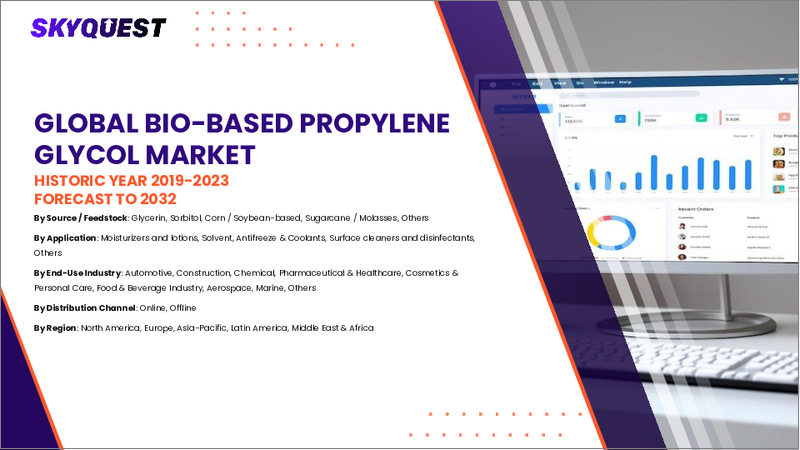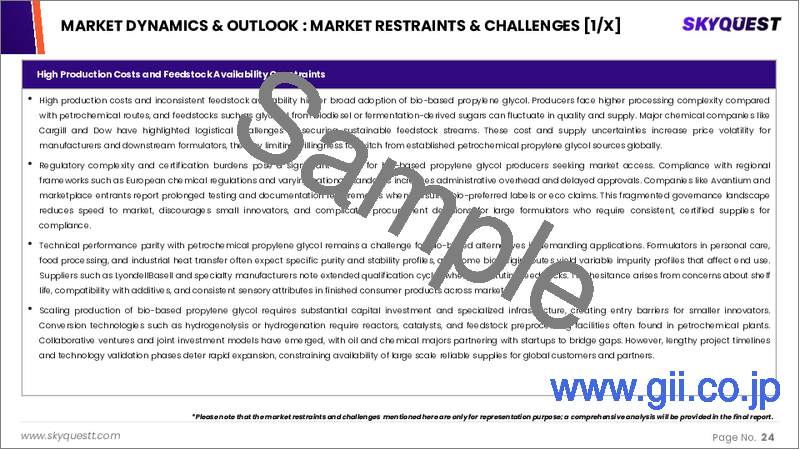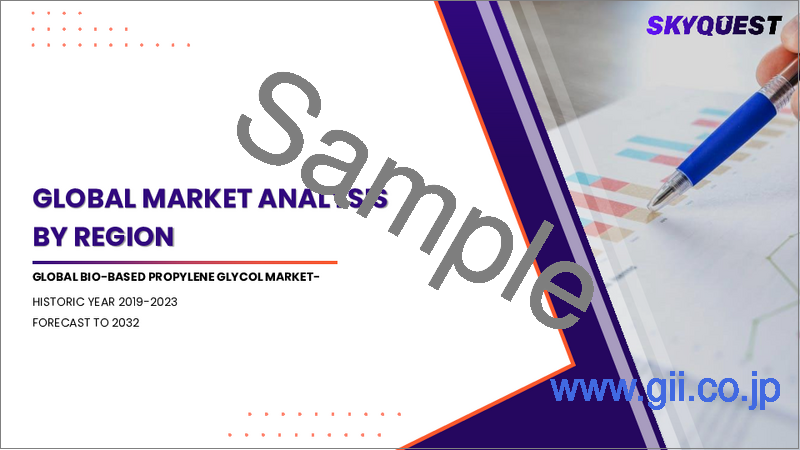|
|
市場調査レポート
商品コード
1603262
バイオベースプロピレングリコールの市場規模、シェア、成長分析、供給源別、グレード別、用途別、最終用途産業別、地域別 - 産業予測、2024年~2031年Bio-based Propylene Glycol Market Size, Share, Growth Analysis, By Source, By Grade, By Application, By End Use Industry, By Region - Industry Forecast 2024-2031 |
||||||
|
|||||||
| バイオベースプロピレングリコールの市場規模、シェア、成長分析、供給源別、グレード別、用途別、最終用途産業別、地域別 - 産業予測、2024年~2031年 |
|
出版日: 2024年11月25日
発行: SkyQuest
ページ情報: 英文 157 Pages
納期: 3~5営業日
|
全表示
- 概要
- 目次
バイオベースプロピレングリコールの世界市場規模は2022年に44億1,000万米ドルと評価され、2023年の45億9,000万米ドルから2031年には64億1,000万米ドルに成長し、予測期間(2024-2031年)のCAGRは4.4%で成長する見通しです。
世界のバイオベースプロピレングリコール市場は、従来のプロピレングリコールに代わる持続可能で環境に優しい代替品への需要の高まりに後押しされ、堅調な拡大を見せています。主な市場促進要因としては、厳しい環境規制、石油由来製品の悪影響に関する消費者の意識の高まり、さまざまな分野でのバイオベース原料への傾斜の高まりなどが挙げられます。二酸化炭素排出量の削減、生分解性、低毒性といったバイオベースプロピレングリコールの利点により、化粧品、医薬品、飲食品、パーソナルケア製品など、多様な用途で好まれる選択肢となっています。さらに、この市場は、エンドユーザーの進化する要件に対応することを目的とした継続的な技術革新と製品開拓によって特徴付けられ、その結果、新たな成長軌道と拡大機会を生み出しています。持続可能性が重要な意味を持ち続ける中、バイオベースプロピレングリコール分野は、環境に優しいソリューションを求める消費者や産業界の嗜好の高まりに応えることで、持続的な成長を遂げる態勢を整えています。ダイナミックな市場力学と環境配慮型製品への注目の高まりにより、世界のバイオベースプロピレングリコール市場は、化学用途におけるより環境に優しい代替品への幅広いシフトを反映して、成長するものと思われます。
目次
イントロダクション
- 調査の目的
- 調査範囲
- 定義
調査手法
- 情報調達
- 二次データと一次データの方法
- 市場規模予測
- 市場の前提条件と制限
エグゼクティブサマリー
- 世界市場の見通し
- 供給と需要の動向分析
- セグメント別機会分析
市場力学と見通し
- 市場概要
- 市場規模
- 市場力学
- 促進要因と機会
- 抑制要因と課題
- ポーター分析と影響
- 競争企業間の敵対関係
- 代替品の脅威
- 買い手の交渉力
- 新規参入業者の脅威
- 供給企業の交渉力
主な市場の考察
- 重要成功要因
- 競合の程度
- 主な投資機会
- 市場エコシステム
- 技術の進歩
- 規制情勢
- バリューチェーン分析
- ケーススタディ分析
- 顧客と購買基準の分析
- PESTEL分析
- マクロ経済指標
- 市場の魅力指数
- 価格分析
バイオベースプロピレングリコールの市場規模:供給源別& CAGR(2024-2031)
- 市場概要
- 石油系
- バイオベース
バイオベースプロピレングリコールの市場規模:グレード別& CAGR(2024-2031)
- 市場概要
- 工業グレード
- USPグレード
バイオベースプロピレングリコールの市場規模:用途別& CAGR(2024-2031)
- 市場概要
- 不飽和ポリエステル樹脂
- 溶媒
- 不凍液と冷却液
- 化学中間体
- その他
バイオベースプロピレングリコールの市場規模:最終用途産業別& CAGR(2024-2031)
- 市場概要
- 食品・飲料化粧品
- 建築・建設
- 自動車
- 製薬
- 洗剤・家庭用品
- その他
バイオベースプロピレングリコールの市場規模& CAGR(2024-2031)
- 北米
- 米国
- カナダ
- 欧州
- 英国
- ドイツ
- スペイン
- フランス
- イタリア
- その他欧州地域
- アジア太平洋
- 中国
- インド
- 日本
- 韓国
- その他アジア太平洋地域
- ラテンアメリカ
- ブラジル
- その他ラテンアメリカ地域
- 中東およびアフリカ
- GCC諸国
- 南アフリカ
- その他中東・アフリカ
競合情報
- 上位5社の比較
- 主要企業の市場ポジショニング(2023年)
- 主な市場企業が採用した戦略
- 市場の最近の動向
- 企業の市場シェア分析(2023年)
- 主要企業の企業プロファイル
- 会社概要
- 製品ポートフォリオ分析
- セグメント別シェア分析
- 収益の前年比比較(2021-2023)
主要企業プロファイル
- Archer Daniels Midland Company(ADM)
- BASF SE
- Ashland Inc.
- Cargill, Incorporated
- Oleon(partnership with BASF)
- SK Chemicals
- Huntsman International LLC
- The Dow Chemical Company
- DuPont Tate & Lyle Bio Products
- Repsol
- Temix Oleo S.R.L.
- Global Bio-Chem Technology Group
- INEOS Oxide
- LyondellBasell Industries
- Shell Chemicals
- Solvay S.A.
- Asahi Kasei Corporation
- Evonik Industries AG
- Braskem
- Reverdia
結論と推奨事項
Global Bio-based Propylene Glycol Market size was valued at USD 4.41 billion in 2022 and is poised to grow from USD 4.59 billion in 2023 to USD 6.41 billion by 2031, growing at a CAGR of 4.4% during the forecast period (2024-2031).
The Global Bio-based Propylene Glycol market is witnessing robust expansion, fueled by the escalating demand for sustainable and eco-friendly alternatives to conventional propylene glycol. Key market drivers include stringent environmental regulations, heightened consumer awareness regarding the detrimental effects of petroleum-derived products, and a growing inclination towards bio-based ingredients across various sectors. The advantages of bio-based propylene glycol, such as a reduced carbon footprint, biodegradability, and lower toxicity, position it as a favored option in diverse applications including cosmetics, pharmaceuticals, food and beverages, and personal care products. Moreover, the market is characterized by ongoing innovation and product development aimed at addressing the evolving requirements of end-users, thus creating new growth trajectories and expansion opportunities. As sustainability continues to gain significance, the bio-based propylene glycol sector is well-poised for sustained growth, catering to the increasing preference among consumers and industries alike for environmentally friendly solutions. With dynamic market dynamics and a heightened focus on eco-conscious products, the global bio-based propylene glycol market is set to thrive, reflecting the broader shift towards greener alternatives in chemical applications.
Top-down and bottom-up approaches were used to estimate and validate the size of the Global Bio-Based Propylene Glycol market and to estimate the size of various other dependent submarkets. The research methodology used to estimate the market size includes the following details: The key players in the market were identified through secondary research, and their market shares in the respective regions were determined through primary and secondary research. This entire procedure includes the study of the annual and financial reports of the top market players and extensive interviews for key insights from industry leaders such as CEOs, VPs, directors, and marketing executives. All percentage shares split, and breakdowns were determined using secondary sources and verified through Primary sources. All possible parameters that affect the markets covered in this research study have been accounted for, viewed in extensive detail, verified through primary research, and analyzed to get the final quantitative and qualitative data.
Global Bio-Based Propylene Glycol Market Segmental Analysis
One dominant region in the market is North America. The region is witnessing significant growth due to the increasing demand for sustainable and bio-based products, coupled with strict regulations promoting the use of eco-friendly ingredients. The presence of key players and technological advancements in bio-based propylene glycol production further contribute to the dominance of this region. North America has a well-established market infrastructure, favorable government policies, and a growing consumer base that emphasizes environmentally friendly products.
Driver of the Global Bio-Based Propylene Glycol Market
A significant driver of the Global Bio-Based Propylene Glycol market is the rising demand for sustainable and environmentally friendly products. As consumers grow increasingly aware of their ecological impact, they tend to favor bio-based options over conventional petroleum-derived chemicals. Bio-based propylene glycol presents a renewable and biodegradable alternative that lessens dependence on fossil fuels while helping to mitigate environmental damage. This trend is further bolstered by governmental policies and regulations that advocate for the adoption of bio-based products. Consequently, the shift towards greener options is driving growth in the bio-based propylene glycol sector, aligning with global sustainability goals.
Restraints in the Global Bio-Based Propylene Glycol Market
A significant restraint in the Global Bio-Based Propylene Glycol market is its higher cost relative to petroleum-based alternatives. The production of bio-based propylene glycol utilizes advanced technologies and specific raw materials, leading to increased manufacturing expenses. This price disparity can hinder its broader acceptance, particularly in price-sensitive sectors where cost efficiency is paramount. Although current pricing may pose challenges, ongoing technological advancements and the potential for economies of scale may help reduce this cost difference over time, suggesting that this restraint could become less impactful as the market evolves.
Market Trends of the Global Bio-Based Propylene Glycol Market
The global bio-based propylene glycol market is experiencing a significant upward trend driven by an increasing preference for sustainable and eco-friendly agents across various industries. As consumers and manufacturers alike become more environmentally conscious, there is a pronounced shift towards renewable and bio-based alternatives that minimize reliance on traditional petroleum-derived chemicals. Bio-based propylene glycol, produced from renewable feedstocks like agricultural waste and biomass, stands out for its lower carbon footprint and contribution to sustainability goals. This trend is bolstered by supportive government regulations, consumer advocacy for greener products, and the integration of sustainable practices in sectors such as cosmetics, pharmaceuticals, food and beverages, and automotive, reinforcing the commitment within the market to embrace environmental stewardship and innovate with greener solutions.
Table of Contents
Introduction
- Objectives of the Study
- Scope of the Report
- Definitions
Research Methodology
- Information Procurement
- Secondary & Primary Data Methods
- Market Size Estimation
- Market Assumptions & Limitations
Executive Summary
- Global Market Outlook
- Supply & Demand Trend Analysis
- Segmental Opportunity Analysis
Market Dynamics & Outlook
- Market Overview
- Market Size
- Market Dynamics
- Driver & Opportunities
- Restraints & Challenges
- Porters Analysis & Impact
- Competitive rivalry
- Threat of substitute
- Bargaining power of buyers
- Threat of new entrants
- Bargaining power of suppliers
Key Market Insights
- Key Success Factors
- Degree of Competition
- Top Investment Pockets
- Market Ecosystem
- Technological Advancement
- Regulatory Landscape
- Value Chain Analysis
- Case Study Analysis
- Customer & Buying Criteria Analysis
- PESTEL Analysis
- Macro-Economic Indicators
- Market Attractiveness Index
- Pricing Analysis
Global Bio-based Propylene Glycol Market Size by Source & CAGR (2024-2031)
- Market Overview
- Petroleum based
- Bio Based
Global Bio-based Propylene Glycol Market Size by Grade & CAGR (2024-2031)
- Market Overview
- Industrial Grade
- USP Grade
Global Bio-based Propylene Glycol Market Size by Application & CAGR (2024-2031)
- Market Overview
- Unsaturated Polyester Resin
- Solvent
- Antifreeze & Coolant
- Chemical Intermediates
- Others
Global Bio-based Propylene Glycol Market Size by End Use Industry & CAGR (2024-2031)
- Market Overview
- Food & Beverages, Cosmetics
- Building & Construction
- Automotive
- Pharmaceutical
- Detergent & Household
- Others
Global Bio-based Propylene Glycol Market Size & CAGR (2024-2031)
- North America, (Source, Grade, Application, End Use Industry)
- US
- Canada
- Europe, (Source, Grade, Application, End Use Industry)
- UK
- Germany
- Spain
- France
- Italy
- Rest of Europe
- Asia-Pacific, (Source, Grade, Application, End Use Industry)
- China
- India
- Japan
- South Korea
- Rest of Asia Pacific
- Latin America, (Source, Grade, Application, End Use Industry)
- Brazil
- Rest of Latin America
- Middle East & Africa, (Source, Grade, Application, End Use Industry)
- GCC Countries
- South Africa
- Rest of Middle East & Africa
Competitive Intelligence
- Top 5 Player Comparison
- Market Positioning of Key Players, 2023
- Strategies Adopted by Key Market Players
- Recent Developments in the Market
- Company Market Share Analysis, 2023
- Company Profiles of All Key Players
- Company Details
- Product Portfolio Analysis
- Company's Segmental Share Analysis
- Revenue Y-O-Y Comparison (2021-2023)
Key Company Profiles
- Archer Daniels Midland Company (ADM)
- Company Overview
- Business Segment Overview
- Financial Updates
- Key Developments
- BASF SE
- Company Overview
- Business Segment Overview
- Financial Updates
- Key Developments
- Ashland Inc.
- Company Overview
- Business Segment Overview
- Financial Updates
- Key Developments
- Cargill, Incorporated
- Company Overview
- Business Segment Overview
- Financial Updates
- Key Developments
- Oleon (partnership with BASF)
- Company Overview
- Business Segment Overview
- Financial Updates
- Key Developments
- SK Chemicals
- Company Overview
- Business Segment Overview
- Financial Updates
- Key Developments
- Huntsman International LLC
- Company Overview
- Business Segment Overview
- Financial Updates
- Key Developments
- The Dow Chemical Company
- Company Overview
- Business Segment Overview
- Financial Updates
- Key Developments
- DuPont Tate & Lyle Bio Products
- Company Overview
- Business Segment Overview
- Financial Updates
- Key Developments
- Repsol
- Company Overview
- Business Segment Overview
- Financial Updates
- Key Developments
- Temix Oleo S.R.L.
- Company Overview
- Business Segment Overview
- Financial Updates
- Key Developments
- Global Bio-Chem Technology Group
- Company Overview
- Business Segment Overview
- Financial Updates
- Key Developments
- INEOS Oxide
- Company Overview
- Business Segment Overview
- Financial Updates
- Key Developments
- LyondellBasell Industries
- Company Overview
- Business Segment Overview
- Financial Updates
- Key Developments
- Shell Chemicals
- Company Overview
- Business Segment Overview
- Financial Updates
- Key Developments
- Solvay S.A.
- Company Overview
- Business Segment Overview
- Financial Updates
- Key Developments
- Asahi Kasei Corporation
- Company Overview
- Business Segment Overview
- Financial Updates
- Key Developments
- Evonik Industries AG
- Company Overview
- Business Segment Overview
- Financial Updates
- Key Developments
- Braskem
- Company Overview
- Business Segment Overview
- Financial Updates
- Key Developments
- Reverdia
- Company Overview
- Business Segment Overview
- Financial Updates
- Key Developments






